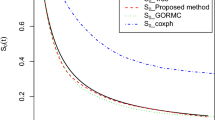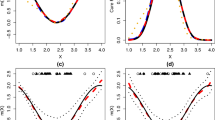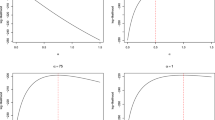Abstract
A mixture cure model has been increasingly popular in the field of biostatistics, where some individuals may never experience an event of interest during a study. In most cases, effects of continuous covariates are assumed to be linear. However, a traditional linear assumption often fails in practical situations because real-life effects are usually nonlinear. Proposed is a linear spline Cox cure model in which a spline is used to approximate the unknown smooth functional form for the effect of a continuous covariate to identify the nonlinear functional relationship. The justification and estimation procedure starts from Laplace’s approximation of the marginal log-likelihood function and leads to a penalized log-likelihood. The expectation-maximization algorithm is used to estimate the model parameters, and the proposed methodology could then be used to assess the linearity of the continuous covariate effect via the likelihood ratio procedure. An extensive simulation study is conducted to investigate the performance of the proposed lack-of-fit test for the linearity of the continuous covariate effect. The practical use of the methodology is illustrated with fibrous histiocytoma data from the Surveillance, Epidemiology, and End Results (SEER) program database.







Similar content being viewed by others
Data availability statements
The data that support the findings of this study are available from the Surveillance, Epidemiology, and End Results (SEER) program November 2017 submission database. Here is the URL for the description: https://seer.cancer.gov/data-software/documentation/seerstat/nov2017/ and the data dictionary: https://seer.cancer.gov/data-software/documentation/seerstat/nov2017/seerstat-variable-dictionary-nov2017.pdf. Restrictions apply to the availability of these data, which were used under license for this study. Data are available from the authors with the permission of SEER.
References
Aalen O (1978) Nonparametric inference for a family of counting processes. Ann Stat 6:701–726. https://doi.org/10.1214/aos/1176344247
Breslow NE, Clayton DG (1993) Approximate inference in generalized linear mixed models. J Am Stat Assoc 88:9–25. https://doi.org/10.2307/2290687
Crainiceanu CM, Ruppert D, Vogelsang TJ (2002) Probability that the MLE of a variance component is zero with applications to likelihood ratio tests. https://people.orie.cornell.edu/davidr/papers/probzero01.pdf
Davison AC, Hinkley DV (1997) Bootstrap methods and their application. University Press, Cambridge
Farewell VT (1982) The use of mixture models for the analysis of survival data with long-term survivors. Biometrics 38:1041–1046. https://doi.org/10.2307/2529885
Kaplan EL, Meier P (1958) Nonparametric estimation from incomplete observations. J Am Stat Assoc 53:457–481. https://doi.org/10.2307/2281868
Kuk AYC, Chen CH (2006) A mixture model combining logistic regression with proportional hazards regression. Biometrika 101:531–541. https://doi.org/10.2307/2336784
Masud AA, Yu Z, Tu W (2019) Variable selection and nonlinear effect discovery in partially linear mixture cure rate models. Biostat Epidemiol 31:156–177. https://doi.org/10.1080/24709360.2019.1663665
Nelson W (1969) Hazard plotting for incomplete failure data. J Qual Technol 1:27–52. https://doi.org/10.1080/00224065.1969.11980344
Nelson W (1972) Theory and applications of hazard plotting for censored failure data. Technometrics 14:945–965. https://doi.org/10.2307/1267144
Peng Y, Dear KBG (2000) A nonparametric mixture model for cure rate estimation. Biometrics 56:237–243. https://doi.org/10.1111/j.0006-341X.2000.00237.x
Peng Y, Taylor JMG (2011) Mixture cure model with random effects for the analysis of a multi-center tonsil cancer study. Stat Med 30:201–300. https://doi.org/10.1002/sim.4098
Peng Y, Taylor JMG (2017) Residual-based model diagnosis methods for mixture cure models. Biometrics 73:495–505. https://doi.org/10.1111/biom.12582
Ripatti S, Palmgren J (2000) Estimation of multivariate frailty models using penalized partial likelihood. Biometrics 56:1016–1022. https://doi.org/10.1111/j.0006-341X.2000.01016.x
Ruppert D, Wand MP, Carroll RJ (2003) Semiparametric regression. Cambridge University Press, Cambridge
Shao F, Li J, Ma S, Lee MLT (2014) Semiparametric varying-coefficient model for interval censored data with a cured proportion. Stat Med 33(10):1700–1712. https://doi.org/10.1002/sim.6054
Acknowledgements
The authors thank two referees and an Associate Editor for their constructive comments that improved the presentation.
Author information
Authors and Affiliations
Corresponding author
Ethics declarations
Conflict of interest
The authors received no specific funding for this work. The authors have no relevant financial or non-financial interests to disclose.
Additional information
Publisher's Note
Springer Nature remains neutral with regard to jurisdictional claims in published maps and institutional affiliations.
Supplementary Information
Below is the link to the electronic supplementary material.
Rights and permissions
About this article
Cite this article
Liu, Y., Li, CS. A linear spline Cox cure model with its applications. Comput Stat 38, 935–954 (2023). https://doi.org/10.1007/s00180-022-01252-1
Received:
Accepted:
Published:
Issue Date:
DOI: https://doi.org/10.1007/s00180-022-01252-1




